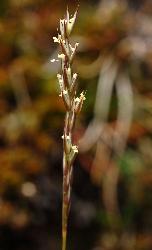- Taxon
- Gallery
Open to dense, stiff tufts or small tussocks, 6–35–(55) cm; branching extravaginal. Leaf-sheath subcoriaceous, distinctly ribbed, smooth, or sparsely scabrid to densely scaberulous between ribs, light green to light brown, rarely purplish. Ligule 0.5–2 mm, truncate, abaxially smooth or rarely sparsely minutely hairy or scabrid. Leaf-blade 2.5–15 cm × 0.3–1.5 mm, folded with inrolled margins, setaceous to filiform or wiry, abaxially smooth, or rarely scabrid, adaxially scabrid on ribs, margins sparsely scabrid, narrowed to blunt tip. Culm 4–35 cm, erect or curved, sometimes geniculate at base, nodes usually inconspicuous, internodes either distinctly scabrid below panicle (most North Id plants), to slightly scabrid near panicle or completely smooth. Panicle 2–5.5–(11) cm × (2)–3–18–(22) mm, ± loosely spiciform, narrowly branched, widest at anthesis, later becoming contracted; rachis, branches and pedicels densely scabrid, or rachis smooth and branches scabrid or smooth. Spikelets 3–5.5 mm, greenish or purplish, becoming pale brown. Glumes 1–3-nerved, linear- to elliptic-lanceolate, acute, membranous, often scabrid near tip and on midnerve above. Lemma (2)–2.4–3.8 mm, usually ± ¾ length of glumes, submembranous, smooth to finely papillose, sometimes finely scabrid above, ovate-lanceolate, apex hyaline, truncate, denticulate; awn 2–4.5 mm, usually stout and reflexed, projecting from between glumes, occasionally slightly twisted at base, from upper ⅓ of lemma or c. middorsal. Palea ˜ lemma, keels scabrid in upper ½, interkeel sometimes sparsely scabrid, apex obtuse or bifid. Callus hairs rather dense, 1.5–2.5 mm, c. ½-⅔ length of lemma, very rarely = lemma. Rachilla prolongation 1–1.5 mm, tipped by a strong tuft of hairs 1–2 mm reaching lemma apex or slightly overtopping lemma. Lodicules 0.6–1 mm, lanceolate, subacute. Anthers 0.6–1.4 mm. Caryopsis 1.6–2.2 × 0.4–0.9 mm.
[From: Edgar and Connor (2000) Flora of New Zealand. Volume 5 (second printing).]




